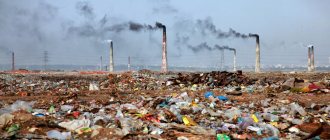Legal advice > Administrative law > Criminal liability for environmental crimes: concept, types, features
An environmental crime is a deliberate attack on the safety of the environment: deliberate damage and pollution of natural resources are recognized as a criminal offense, since they pose a significant public danger.
Humans are part of nature, and any illegal action associated with the thoughtless destruction of resources can cause enormous harm to hundreds of people and disrupt the well-being of society. The state seeks to take control of natural resources in order to protect them from theft and destruction; criminal liability for environmental crimes is an important deterrent.
Features of legislation in the field of ecology
Criminal liability for environmental crimes will help to save the Earth to some extent
There is no definition of environmental crime in the Criminal Code, but there is one in section 81 of the Environmental Protection Act 1991. Until recently, it was believed that crimes related to encroachment on the environment caused only economic damage, but now ideas about them have changed significantly.
The modern definition says: an environmental crime is a dangerous act that encroaches on the environmental safety of society and violates environmental law and order. This definition contains very important information: an environmental crime is not just causing damage, but an attack on a person through the nature surrounding him. This crime violates the constitutional law reflected in Art. 42: every citizen of the Russian Federation has the right to a healthy environment.
The subject of an environmental crime can be a person who has reached the age of 16, according to Art. 246 of the Criminal Code, both a private person and an official can be recognized as a subject. The specific object of such a crime is social relations established in the sphere of environmental management, as well as the preservation of an environmental balance favorable to humans.
An action or inaction in violation of established environmental rules and regulations may be recognized as a crime. The subject of a crime is any component of the environment - it can be soil, a natural body of water, wild animals, birds and much more.
Classification
If the offense includes objects of encroachment from a group of homogeneous offenses, the following classification takes place:
- Illegal destruction and damage to natural resources, such as pollution, water pollution, destruction of forest areas, significant damage to agricultural land.
- Violation and disregard of the rules for the transfer of ownership of natural resources associated with the possibility of causing damage to the environment. Such violations include the introduction into operation of technical structures and enterprises that cause damage to the environment.
- Inaction or failure to comply with established rules for the conservation of natural resources.
- Deliberate use of various natural resources for one's own selfish purposes. For example, collecting wild rare plants.
Subject of environmental crime
Crimes against nature
First of all, you need to decide what exactly can be considered the object of an attack, and in which case it is a misdemeanor and in which case it is a crime. Environmental legislation is aimed at protecting natural objects, and they have several specific features:
- Natural origin. If, as a result of illegal actions, green spaces on a farm or summer cottage were, for example, destroyed, we are not talking about an environmental violation. This branch of law deals only with those objects that were formed without human participation. If any agricultural objects were destroyed, economic damage will be calculated and the relevant legislation will apply.
- Ecological dependence on the environment. In nature, everything is interconnected: poisoning of rivers leads to mass deaths of fish and mammals, cutting down trees causes migration and death of animals. The task of environmental legislation is to prevent a violation of the ecological balance and stop the causing of damage.
- Ecological value for human society. The state is the sole owner of natural resources; it is obliged to strictly control the extraction of all types of minerals, including groundwater. The environmental value of an object is determined according to different criteria: the more important it is, the more stringent the liability for damage caused will be.
An environmental crime is recognized not only as causing real harm to the environment, but also as creating a situation of danger. For example, if an organization violates the rules for transporting and storing hazardous waste, it will be held liable under the law even if no leakage occurs. This measure is intended to prevent crime and prevent imbalances due to the negligence of those responsible.
Types of environmental offenses
There are 3 types of environmental violations. This:
- Committed by the legal owners of natural resources.
- Committed by nature users.
- Committed by persons who do not belong to any of these subgroups.
The next criterion is the state of natural objects in relation to which environmental violations have been identified. This:
- Damage.
- Destruction.
- Causing damage.
According to the object of encroachment, types of environmental offenses are distinguished into: mountain, land, water, forest.
Types of environmental crimes
Some damage done is irreversible
A complete list of environmental crimes can be found in Chapter 26 of the Criminal Code: in total there are 17 crimes against nature. Depending on the objects of illegal actions, all crimes can be divided into several groups:
- General crimes aimed against environmental protection. It may be associated with construction work, storage and transportation of hazardous waste, microbiological preparations, violation of the rules for the use of special environmental areas, etc. This group includes all illegal acts associated with insufficient protection of nature from human activity.
- The second group includes crimes related to encroachment on the safety of the land and subsoil. These include damage to the fertile layer of soil by waste, illegal mining, violation of rules for the development of the earth's subsoil, and much more. Any acts related to illegal mining and soil imbalance are considered socially dangerous.
- Crimes affecting public water relations. These include pollution of the world's oceans and fresh natural bodies of water, violation of the rules for the development of the continental shelf, violation of the exclusive zone of the Russian Federation in the Arctic, etc.
- Crimes against vegetation. Illegal deforestation, violation of rules when using pesticides and herbicides, violation of rules for staying in nature reserves, destruction of aquatic plants, etc. The state is obliged to protect the flora, since the ecological well-being of the entire human society primarily depends on it, and any unlawful interference can cause an environmental disaster.
- Crimes against animals. This includes hunting in unspecified places, violations of fishing rules, violation of the habitat conditions of rare and endangered animals. This group also includes hunting in nature reserves (poaching) and other crimes related to the destruction of living beings.
- Crimes against the atmosphere. All over the world there is now a struggle to reduce the amount of harmful emissions into the atmosphere, as well as to reduce gases that provoke the greenhouse effect.
In Russia, the requirements are still much softer than in Europe, and as a result, entrepreneurs are in no hurry to modernize production. Atmospheric pollution contributes to global warming; any violations in this area should be strictly punished by the state.
Liability for harm caused to the environment is also provided for in other types of criminal legislation. Chapter 24, which deals with crimes against public safety, provides for penalties for violating the rules for maintaining nuclear power plants, mining operations, the use of explosives, etc.
Article 358 in Chapter 34 provides for liability for ecocide - mass destruction of flora and fauna. Thus, various sections of legislation are aimed at preventing harm to the environment.
Onset of administrative liability
Administrative liability for environmental offenses occurs in accordance with the commission of illegal actions intentionally or through negligence.
Violators of administrative proceedings are subject to penalties in the form of fines, warnings, confiscation, confiscation of weapons and deprivation of special rights of individuals to carry out a certain type of activity in connection with which the damage was caused.
The list of violations fully corresponds to criminal offenses with the difference that administrative environmental offenses did not cause harm to human health or did not lead to the destruction of plant and animal resources, but, nevertheless, caused significant damage or were aimed at achieving certain criminal offenses, but were not fully implemented.
Types of criminal punishment
Not everyone is always punished for environmental crimes
Unfortunately, environmental crimes do not always come to court quickly, and for many crimes the punishment can be considered too lenient. Now the legislation is being improved, liability is assigned depending on the extent of the damage caused. The following criminal penalties may be applied to violators of environmental laws:
- A fine of up to 500 minimum wages. For individuals, the fine will be much lower than for officials or organizations that violated environmental legislation. The fine is most often accompanied by confiscation of the instrument of the crime: for example, nets and other devices for illegal fishing are confiscated from caught poachers.
- Deprivation of the right to engage in certain work or hold certain positions. The period of imprisonment can reach 5 years depending on the severity of the damage caused. This measure is aimed primarily at officials of various departments, due to whose negligence or inaction a gross violation of the law may occur.
- Correctional labor for up to two years. In this case, the convicted person works at his main place of employment, but 20% of his earnings is withheld in favor of the state. For example, for air pollution, the period of correctional labor for an official can be up to 1 year.
- Restriction of freedom for up to three years. This type of punishment provides for control over the movements of the convicted person, a ban on leaving home at certain times to attend public events, etc.
- Compulsory work for up to 240 hours. The duration of work is determined by the severity of the damage caused. The court determines the number of hours that the convicted person must work for free for the benefit of society.
- Arrest for up to 6 months. This is one of the most serious punishments, as it involves isolation from society for up to six months.
- Imprisonment for various periods depending on the severity of the harm caused. In practice, imprisonment for environmental crimes is used quite rarely; it is usually replaced by a suspended sentence or other penalties.
It is difficult to answer what punishment is sufficient for causing harm to nature, after which hundreds and even thousands of people may suffer in the future. Now the criminal code in this area is expanding and being finalized, as society’s attitude to the problem is changing.
Criminal prosecution is not so much a punishment as it is a deterrent to stop violators and prevent harm to the environment.
Increase in fines
I consider it my duty to inform you that
On November 22, 2021, a meeting of the Federation Council Committee on Natural Resources was held, where draft federal law N 507370-7 “On Amendments to the Code of the Russian Federation on Administrative Offenses” , according to which it is proposed to increase penalties under Articles 8.13 ( violation rules for the protection of water bodies ) and 8.14 ( violation of water use rules ).
For example, it is proposed to increase the maximum amount of an administrative fine:
- 5 times - in part 1 of Article 8.13 (from 20 to 100 thousand rubles);
- 5 times - in part 1 of Article 8.14 (from 20 to 100 thousand rubles)
And on November 23, the provision of Federal Law No. 407-FZ of November 12, 2021 came into force.
The changes affected Article 8.42 ( violation of the special regime for carrying out economic and other activities on the coastal protective strip of a water body... )
Let me remind you of the contents of the articles:
Article 8.13 part 1 Violation of the water protection regime in the catchments of water bodies, which may lead to pollution of these objects or other harmful phenomena
Article 8.14 part 1 Violation of water use rules when withdrawing water, without withdrawing water and when discharging wastewater into water bodies
Article 8.42 part 1 Use of the coastal protective strip of a water body, water protection zone of a water body in violation of restrictions on economic and other activities.
Other types of liability for crimes against the environment
Industry needs to be controlled...
Environmental violations do not always lead to criminal prosecution. Environmental authorities can also use other methods of influencing violators: they not only prevent further attacks on the environmental well-being of the area, but also help to partially compensate for the damage caused. Liability for such offenses can be of several types:
- Disciplinary. This type of liability is applied by the enterprise to an employee who has committed deviations from established rules in the field of environmental protection. However, it is only possible if the violator has deviated from his labor duties assigned in the contract. Responsibility measures can be a reprimand, severe reprimand, dismissal, demotion, etc.
- Financial liability – recovery of compensation for damage caused. Both an individual and a legal entity can be financially responsible. Fines for damage caused to nature are collected in court, their amount is determined by the amount of damage.
- Administrative responsibility. Used in case of violation of the norms of the Code of Administrative Offenses of the Russian Federation; it can be applied to individuals, entrepreneurs and organizations. Administrative liability usually entails the imposition of a large fine for violation of the environmental code. Chapter 8 of the Code provides for liability for violation of building codes, rules for handling chemicals, etc.
- Criminal liability for violation of environmental legislation is also usually divided into two types: it can be general and special. In the first case, punishment is imposed for an attack on nature as a whole: such an act is socially dangerous, it threatens the well-being of many people, and therefore the responsibility for it will be very serious. Special criminal liability involves punishment for encroachment on any one component of the natural balance: atmosphere, soil, water, flora, etc.










